Bacteria found in soil may harbor a potential game-changer for drug design. A new study by Scripps Research, published today in Nature Communications, suggests scientists could build better drugs by learning from bacteria-derived molecules called thiocarboxylic acids.
The finding comes from Ben Shen, Ph.D., and his colleagues on the Florida campus of Scripps Research. The team investigates “natural products” made by organisms such as soil-dwelling bacteria.
“We use natural products as an inspiration for chemistry, biology and drug discovery,” says Shen, professor and co-chair of the Department of Chemistry at Scripps Research.
Thiocarboxylic acids caught Shen’s attention because of their rarity in nature and similarity to lab-made molecules called carboxylic acids. Carboxylic acids are good “warheads” because they can home in on biological targets, making them a key ingredient in many antibiotics, heart disease medications, and more.
Shen and his colleagues took a closer look at two natural products, platensimycin and platencin, that have been extensively investigated as potential antibiotics. Much to their surprise, platensimycin and platencin, which have been known for over a decade to be carboxylic acids, are actually made by bacteria as thiocarboxylic acids.
Find your dream job in the space industry. Check our Space Job Board »
The researchers revealed, for the first time, the exact genes, and the enzymes they encode, that bacteria use to create thiocarboxylic acids.
From there, the scientists set out to test whether nature-made thiocarboxylic acids could also act as biological warheads. The researchers discovered that, as antibiotics, platensimycin and platencin thiocarboxylic acids appeared to bind to their biological targets even better than their carboxylic acid counterparts.
“That was exciting to see,” Shen says. “We’ve now identified thiocarboxylic acids as natural products that can be used as drugs, and thiocarboxylic acids as warheads should be applicable to man-made drugs as well.”
Interestingly, thiocarboxylic acids appear to have been hiding in plain sight. The molecules were thought to be rare and have not been appreciated to date as a family of natural products. Thanks to the current findings, the researchers now know how these producst are made in nature. Upon searching databases of bacterial genomes, the researchers found that many species of bacteria around the world have the genes to produce thiocarboxylic acids.
“There are many, many thiocarboxylic acid natural products waiting to be discovered, making them a treasure trove of potential new drug leads or drugs” says Shen.
Provided by:
The Scripps Research Institute
More information:
Liao-Bin Dong, Jeffrey D. Rudolf, Dingding Kang, Nan Wang, Cyndi Qixin He, Youchao Deng, Yong Huang, K. N. Houk, Yanwen Duan & Ben Shen. Biosynthesis of thiocarboxylic acid-containing natural products. Nature Communications (2018). https://www.nature.com/articles/s41467-018-04747-y
Image:
Culture of a thiocarboxylic acid producing strain of bacteria
Credit: Shen Lab / The Scripps Research Institute











